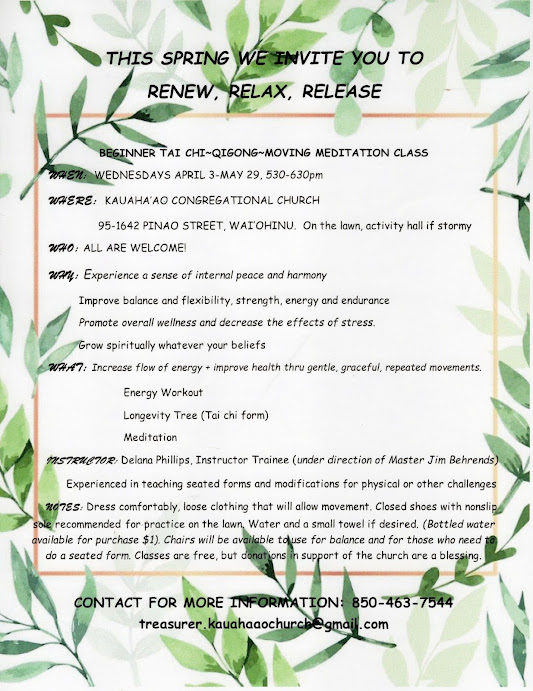The DOFAW statement says it "manages the Forest Reserve System to provide a variety of benefits including recreational and hunting opportunities, watershed restoration, cultural resource preservation, and habitat protection for threatened and endangered native species."
 |
| Kapāpala Forest Reserve is slated to expand by 7,042 acres. Photo from DLNR |
Another proposed addition of land to a Forest Reserve to be heard at the meeting is 162 acres in north Hawaiʻi adjacent to the Manowaialeʻe and Hilo Forest Reserves. It includes a koa seed bank with potential for restoration. The property location also enables public access and opportunity for reforestation activities.
Persons unable to attend or wishing to present additional comments can email forestry@hawaii.gov or mail written testimony, postmarked no later than April 5, to Division of Forestry and Wildlife, Attn: Forestry Program Manager, 1151 Punchbowl St., #325, Honolulu, HI 96813.
 COLLABORATION BETWEEN CIVIL DEFENSE AND USGS TO SAVE LIVES is the subject of this week's Volcano Watch, written by Barry Periatt, Administrative Officer with County of Hawai‘i Civil Defense Agency. Volcano Watch is a weekly article from U.S. Geological Service Hawaiian Volcano Observatory and its affiliates. Here is the story from Periatt:
COLLABORATION BETWEEN CIVIL DEFENSE AND USGS TO SAVE LIVES is the subject of this week's Volcano Watch, written by Barry Periatt, Administrative Officer with County of Hawai‘i Civil Defense Agency. Volcano Watch is a weekly article from U.S. Geological Service Hawaiian Volcano Observatory and its affiliates. Here is the story from Periatt:In Hawaiʻi, HVO monitors the active volcanoes, determines what hazards we can expect during unrest, and tracks eruptions. HVO is also responsible for setting the volcano alert levels and aviation color codes in Hawai‘i and American Samoa, using the USGS Volcano Alert Level System for Volcanoes. In this capacity, HVO notifies federal, state, and local emergency management agencies, as well as the residents and visitors, of notable volcanic unrest and eruptive activity. HCCDA is then responsible for disseminating alerts about volcanic activity (and other natural or man-made hazards) via our public information and warning system. HCCDA is also responsible for making emergency management decisions, such as road closures or evacuations, if communities or infrastructure are being threatened by volcanic activity.
In other places in the world, the responsibilities for setting volcano alert levels and for providing public information and warning appear to be not clearly assigned, or if assigned, not understood by one or more of the organizations involved in the response. This has led to confusion in the public on how serious the threat is and on what actions they need to take. For example, on the Caribbean island of Montserrat, many residents were evacuated in the 1990s from the most threatened area many months before any impacts from eruptions happened. Some individuals who had evacuated returned to their homes because of the lack of impacts, only to perish during the most devasting pyroclastic flow months later. While many factors contributed, in retrospect it appears clearer messaging and communication may have saved more lives.
To read comments, add your own, and like this story, see facebook.com/kaucalendar. See latest events, print edition and archive at kaunews.com. See 7,500 copies the mail and on stands.
VOLCANO ACTIVITY UPDATES: Kīlauea is not erupting. Its USGS Volcano Alert level is ADVISORY.
Low levels of disbursed seismicity continue at Kīlauea's summit and along the Koa'e fault system southwest of the caldera. Earthquake counts remained below 10 per day until March 11; since March 11, there has been a minor increase in activity, with up to 60 disbursed events occurring per day in this region. Tiltmeters near Sand Hill and Uēkahuna bluff have continued to record modest inflationary trends over the past week. No unusual activity has been noted along the rift zones.
Mauna Loa is not erupting. Its USGS Volcano Alert Level is at NORMAL.
Webcams show no signs of activity on Mauna Loa. Summit seismicity has remained at low levels over the past month. Ground deformation indicates continuing slow inflation as magma replenishes the reservoir system following the 2022 eruption. SO2 emission rates are at background levels.
There were no earthquakes reported felt in the Hawaiian Islands during the past week. Email questions to askHVO@usgs.gov.
To read comments, add your own, and like this story, see facebook.com/kaucalendar. See latest events, print edition and archive at kaunews.com. See 7,500 copies the mail and on stands.






.heic)





.heic)




.png)
.png)
.jpg)